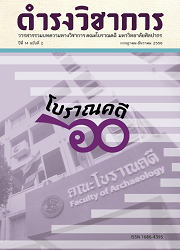Not realizing its value, leads to be a garbage bin: a analitical approach to hortrai lanna
Keywords:
Hotrai, Lanna, ConservationAbstract
A Hortrai is a Dhamma Chedi which the Lanna People highly
respected in days gone past. The history of building a place to keep
scriptures (Hortrai/Dhamma chest) can be traced back to the 12th AD in
the Haripunchai period. During the time of the Mang Rai dynasty, evidence
of the building of Hortrai in Lanna was first found in the inscriptions and
manuscripts during the reign of King Tilokaracha (1441 – 1487).
After a Hortrai was built, a piece of land and some people were
given to the temple in a gesture known as a ‘Wentaan’. It was believed
that building a Hortrai was a positive gesture and as such was undertaken
to make merit in much the same way as the Lord Buddha did in his
previous lives. This resulted in the accumulation of Palami and lead to
one becoming a Bodhisattava.
A Hortrai had different architectural elements which the Lanna
people borrowed from other religious buildings. It had no steps, had a
narrow corridor, small windows and a door which was sometimes hidden.
It was believed that the Hortrai was the place kept specifically for the
Dhamma and was not meant to be disturbed. It was also considered
to be a part of the Triple Gem.
When one wanted to pay homage to a Hortrai, he/she would
place incense sticks, a candle, and some flowers on an altar outside
the Hortrai. A Hortrai was representative of one who maintained the
Threefold Refuge (Tri-saranagomana) which comprises of Buddha,
Dhamma, and Sangha.
Nowadays, people don’t understand the purpose of building a
Hortrai and, because of this, they have changed the design so that it
is similar to that of a Vihara and an Ubosoth. These changes have also
resulted in the Hortrai being used as a library, a living chamber, or a
dining hall, etc. Unfortunately, in the modern era, along with the inability
to read the scriptures, the Hortrai has generally become a functionless
temple library used for storing unused temple items.
References
พรรณเพ็ญ เครือไทย (บรรณาธิการ), 2548. ประชุมจารึกล้านนา เล่ม 9. จารึกในจังหวัดแพร่. เชียงใหม่: มิ่งเมือง.
พระพุทธภุกาม และ พระพุทธญาณ, 2518. ตํานานมูลศาสนา. (แปลโดย สุด ศรีสมวงศ์ และพรหม ขมาลา). กรุงเทพฯ: พิมพ์พระราชทานในงานพระราชทานเพลิงศพ ม.ล. เดช สนิทวงค์ 17 ธันวาคม 2518.
พระรัตนปัญญา, 2517. ชินกาลมาลีปกรณ์. (แปลโดย ร.ต.ท. แสง มนวิทูร). กรุงเทพฯ: พิมพ์เป็นอนุสรณ์ในงานพระราชทานเพลิงศพ ศาสตราจารย์ ร.ต.ท. แสง มนวิทูร เปรียญ ณ ฌาปนสถานคุรุสภา วัดสระเกศราชวรวิหาร 20 เมษายน 2517.
ชัปนะ ปิ่นเงิน. 2548. อานิสงส์ฉบับล้านนา การปริวรรตและสาระสังเขป. เชียงใหม่: สถาบันวิจัยสังคม มหาวิทยาลัยเชียงใหม่.
ฮันส์ เพนธ์ (บรรณาธิการ), 2542. ประชุมจารึกล้านนา เล่ม 3. จารึกในพิพิธภัณฑ์ฯ ลําพูน. เชียงใหม่: มิ่งเมือง.
ระวิวรรณ ภาคพรต, 2525. การกัลปนาในลานนาไทยตั้งแต่กลางพุทธศตวรรษที่ 20 – ต้นพุทธศตวรรษที่ 22 วิทยานิพนธ์ศิลปศาสตรมหาบัณฑิต คณะมนุษยศาสตร์ มหาวิทยาลัยเชียงใหม่.
สถาพร อรุณวิลาส, 2534. คติความเชื่อและรูปแบบหอไตรภาคเหนือตอนบนของประเทศไทย วิทยานิพนธ์ปริญญาศิลปศาสตรมหาบัณฑิต สาขาโบราณคดีสมัยประวัติศาสตร์ ภาควิชาโบราณคดี มหาวิทยาลัยศิลปากร.
พระครูสุธรรมลังกาเจ้าอาวาสวัดชัยศรีภูมิ อําเภอเมือง จังหวัดเชียงใหม่ วันที่ 20 เมษายน 2557.
พระอธิการสุทธพงษ์ ธมฺมสรโณ เจ้าอาวาสวัดดอนแก้ว อําเภอเทิง จังหวัดเชียงราย วันที่ 23 พฤษภาคม 2558.
Downloads
Issue
Section
License
บทความนี้เป็นผลงานของข้าพเจ้าแต่เพียงผู้เดียว และ/หรือเป็นผลงานของข้าพเจ้าและผู้ร่วมงาน ตามชื่อที่ระบุในบทความจริง และเป็นผลงานที่มิได้ถูกนำเสนอหรือตีพิมพ์ที่ใดมาก่อน




